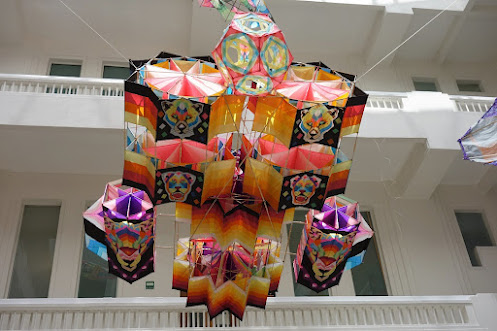My favorite small museum in Mexico City is the Museum of Popular Arts, located in a beautiful art deco building that used to be the headquarters of the fire department.
The museum sponsors the annual parade of monumental "alebrijes". The "alebrijes" are colorful, bizarre creatures made out of papier mache. In this case they are gigantic figures that are wheeled down the streets of Mexico City. Unfortunately they have not held the parade for the last two years because of the pandemic. I talked with an employee of the museum, and he said that by June they will make a decision on whether or not they will once again hold the parade in October. A few of the "alebrijes" from the 2019 parade are on display in the museum courtyard.
The museum recently held a kite-making competition and some of the entries are still hanging from above.
Also in the courtyard was an enormous clay sculpture known as a "Tree of Life". The theme of this "tree" was, appropriately, the popular arts of Mexico.
I've been to the museum numerous times, but my reason for returning last week was to see a special exhibit called "Mestizaje", the blending of the indigenous and the Spanish cultures. Since last year was the 500th anniversary of the Spanish conquest of Mexico, there have been many exhibits dealing with that theme.
The exhibit was small with only 28 pieces of art. But those pieces were exquisite. Seven artists from the state of Oaxaca, with different specialties... wood carving, feather art, weaving, silversmithing, tin ware, and painting on palm mats... collaborated on these works.
Here are a few of the pieces...
These "alebrijes" (the Oaxacan version of the figures are carved from wood) are wearing the metal armor of Spanish soldiers.
Look at the intricate detail of the painting on the wood and the designs on the metal.
This wooden carving features the central figure from the famous Aztec Sun Stone and the feathered serpent god, Quetzalcoatl.
A painting done on a palm mat is the background for this three-dimensional piece. The painting depicts the Valley of Mexico with the two snow covered volcanoes. Attached to the mat is a cross taking root upon a pyramid, and a Spanish helmet and a native headdress.
This three dimensional work also has a painting on a palm mat.
The head of Quetzalcoatl is carved from wood and wreathed with feathers.
Notice that in the painting native warriors are watching the arrival of Spanish ships.
Another special exhibit, one on the art of miniatures, opened yesterday. I won't have a chance to return to the museum, but fortunately the show is running until September. I will have to visit the museum again on my next trip.
















No comments:
Post a Comment